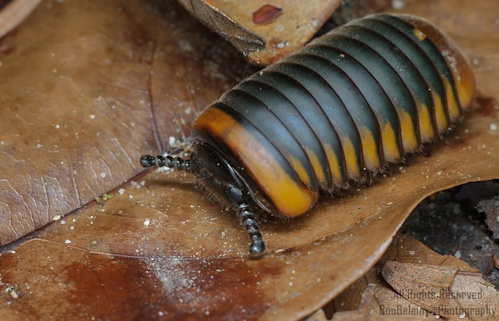| A worker of Ankylomyrma coronacantha (Agroecomyrmecinae), imaged by April Nobile |
Doubtlessly the majority of my posts have been rendered obsolete in some manner since their publication, and thus it would be a task both Sisyphean and unnecessary to keep a finger on them all: instead, I intend here to simply make note of the recent news of which I have become aware.
 |
| A female Allomantispa mirimaculata (Liu et al., 2014) |
- A new genus (and two species) of mantidfly (Mantispidae) has been described: Allomantispa tibetana and mirimaculata (Liu et al., 2014), restricted to the southeastern fringe of the Tibetan Plateau. Notably, Allomantispa is assignable to the Drepanicinae, a subfamily heretofore known to have a relictual distribution in South America and Australia (there are fossil drepanicines known from Eurasia; Makarkin, 1990; Liu et al., 2014). This constitutes a significant addition to the limited information I gave on the taxon in "Mantidflies: Chimeras of the Insect World".
- The reclusive armadillo ants (of which I provided an overview in May 2014)—formerly the sole living members of the Agroecomyrmecinae—now have an extant confamiliar, in the form of the enigmatic Ankylomyrma coronacantha. Formerly shuffled about in the Myrmicinae, the monotypic Ankylomyrmini was found to be sister to Tatuidris tatusia in an extensive phylogenetic re-analysis of that immensely speciose subfamily (Ward et al., 2015). A. coronacantha is nonetheless dissimilar to its cousins in both biogeography (Afrotropical, as opposed to the Neotropical and Holarctic distribution of Agroecomyrmecini living and extinct) and morphoecology (ankylomyrmines are large and arboreal, unlike the diminutive soil-dweller T. tatusia) (Bolton, 1973).
- Despite what I stated as regards the fossil taxon Umenocoleoidea in "The Origin of Earwigs", the type genus Umenocoleus has been reclassified as a beetle (Kirejtshuk et al., 2013). Its supposed relatives remain, however, an odd lineage of "roachoids" unrelated to Umenocoleus (Nel et al., 2014) or to the Protelytoptera, an order in which this exceedingly confusing Cretaceous genus has also been placed (Carpenter, 1992).
___________________________________________________________
Bolton, B. (1973). A remarkable new arboreal ant genus (Hym., Formicidae) from West Africa. Entomologist's Monthly Magazine, 108, 234-237.
Carpenter, F. M. (1992). Treatise on Invertebrate Paleontology (vol. 3, pt. R). Boulder: Geological Society of America.
Kirejtshuk, A. G.; Poschmann, M.; Prokop, J.; Garrouiste, R.; and Nel, A. (2013). Evolution of the elytral venation and structural adaptations in the oldest Paleozoic beetles (Insecta: Coleoptera: Tshekardocoleidae). Journal of Systematic Paleontology, 12, 575-600.
Liu, X.; Winterton, S. L.; Wu, C.; Piper, R.; and Ohl, M. (2014). A new genus of mantidflies discovered in the Oriental region, with a higher-level phylogeny of Mantispidae (Neuroptera) using DNA sequences and morphology. Systematic Entomology, 40, 183-206. Retrieved 12/19/15 from http://onlinelibrary.wiley.com/doi/10.1111/syen.12096/pdf
Makarkin, V. N. (1990). Novye setchatokrylye (Neuroptera) iz verkhnego mela Azii. In: I. A. Akimov (ed.), Novosti Faunistiki I Sistematiki (pp. 63-68). Kiev: Naukova Dumka.
Nel, A.; Prokop, J.; Grandcolas, P.; Garrouste, R.; Lapeyrie, J.; Legendre, F.; Anisyutkin, L. N.; and Kirejtshuk, A. G. (2014). The beetle-like Palaeozoic and Mesozoic roachoids of the so-called "umenocoleoid" lineage (Dictyoptera: Ponopterixidae fam. nov.). Comptes Rendus Palevol, 13(7), 545-554. Retrieved 12/22/15 from http://www.sciencedirect.com/science/article/pii/S1631068314000918
Ward, P. S.; Brady, S. G.; Fisher, B. L.; Schultz, T. R. 2015. The evolution of myrmicine ants: phylogeny and biogeography of a hyperdiverse ant clade (Hymenoptera: Formicidae). Systematic Entomology, 40, 61-81. Retrieved 12/20/15 from http://antcat.s3.amazonaws.com/6341/ward_et_al_2015_syst_entomol_myrmicine_phylogeny_incl_supp_info.pdf?AWSAccessKeyId=AKIAJJR3DGROFMVL2FBQ&Expires=1450660692&Signature=aG8PUYq9Lo3x1jG2z7fP8d8DFyQ%3D


